Envision an old manor house or cottage with English Ivy growing up the walls and around the windows. Lovely? Or is English Ivy a pretty pest?
This post may contain affiliate links from which I can earn a commision, at no cost to you. Visit my full disclosure page here.
English Ivy is listed on many invasive species lists for good reasons. Imported from Europe in the early 18th century, it has made itself at home in most states. It makes a lovely ground cover, but it won’t stay in place.
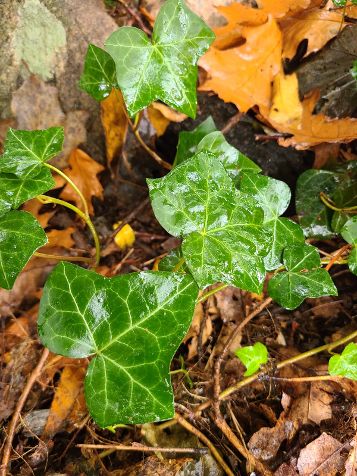
This is the second article I’m sharing in my series about invasive plant species. Don’t miss the first, Stop The Invasion: Japanese Knotweed or the most recent, Garlic Mustard Nutritious Invasive!
English Ivy attaches to trees with its sticky roots suckers, blocking light to tree leaves and weakening the entire tree. Trees infested with English Ivy are more likely to fall during high winds or storms. Wildlife populations are lower in areas with extensive Englishy Ivy infestations. Few animals eat the leaves and though birds may eat the berries, they are often regurgitated.

My mother-in-law loved English Ivy. Since we now own the house my husband grew up in, I’m dealing with the vine everywhere. I like Ivy, but it has gotten completely out of control. When we created my first large garden space in 2006, we needed to remove a huge ivy plot with roots as big as your arm. We dug down a few feet to cut it well below the surface. Thankfully, nothing reemerged.
If you have English Ivy, feel free to enjoy it, but please keep it under control.
Removing English Ivy from the Ground
English Ivy grows all over the bank of our creek. I always figured it helped retain the bank and prevented erosion with its thick roots. But several years ago we had another invasive arrive in our creek bed called dodder. It’s a parasitic plant that invades its host. And it’s favorite host is English Ivy. But that’s another story.

At the back of our property, we have a 70 foot edge bounded by railroad ties in front and an old rock wall in back. It ranges between 6 to 10 feet in depth and curves around to end at the road. with corner. This area became completely filled with English Ivy, a pretty pest.
It’s been a long process removing the ivy, but with my daughter Andie’s help this summer, we’ve made significant progress. I estimate we’ve cleared about 20 feet of ivy.
Since then I’ve been working on pulling out English Ivy whenever time allows. With the chickens free ranging, I generally get work done wherever they are hanging out. The girls are actually helping me recreate our back border.
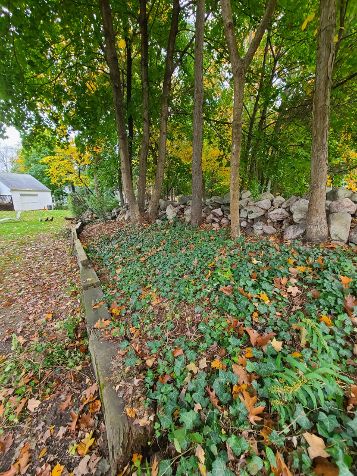
Seventy foot stretch of English Ivy 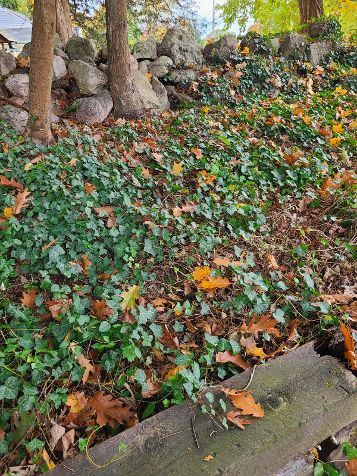
English Ivy covers the ground and rock wall. 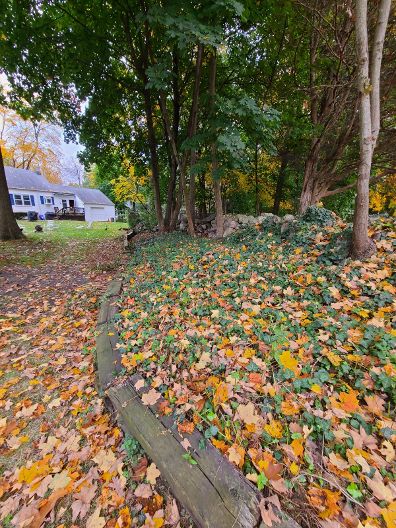
Fall leaves hide a blanket of English Ivy
My preference is to pull the ivy out of the ground stem by stem if necessary. The more roots that get pulled, the less able it will be to rebound. It does take longer, but I’m hanging with my girls!
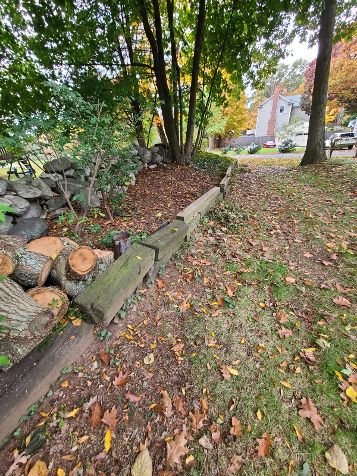
Twenty foot section cleared of Ivy. 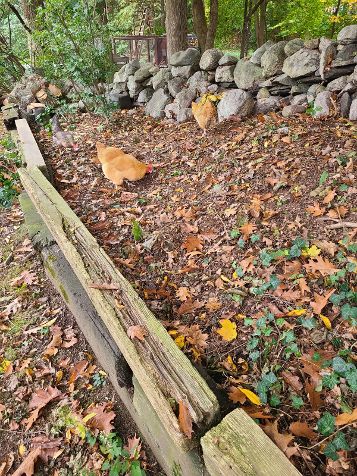
Chickens enjoy scratching and loosening the bare soil.
You can also attack English Ivy with snippers to make pulling it easier. A pair of loppers helps with bigger roots.
In researching this topic, I found several recommendations for clearing large areas or ivy on hills. The idea is to snip all the stems and roots at the top and down the sides of the area, then roll all the ivy into a big log or “cigar” to remove. I tried this, but got frustrated with leaving so many roots in the ground.
How to Remove Ivy from a Tree
I discovered we have a Shagbark Hickory tree at the back of our property. When I was growing up, my family had hickory and black walnut trees and I loved harvesting the nuts to use in the kitchen. We have a huge hickory here with a massive amount of nuts, but it’s a bitternut hickory and basically inedible. The squirrels love them, thank goodness. So I was thrilled to discover this shagbark! It was, however, covered with English Ivy. Thus began my new effort to eradicate it from the back of the property.
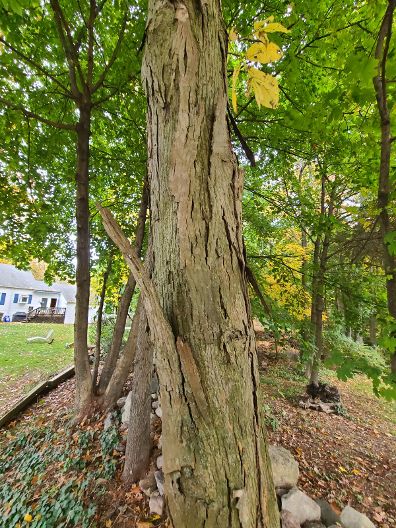

To remove English Ivy from a tree, first cut away all the stem on the ground within 4 to 6 feet of the tree trunk. Be careful working near the tree itself to avoid damage. You will need to clip every strand of ivy at the base of the tree. Then clip all ivy on the tree at about shoulder height.
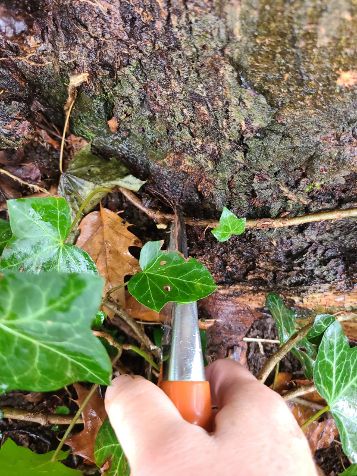
Snip all stems at base of tree 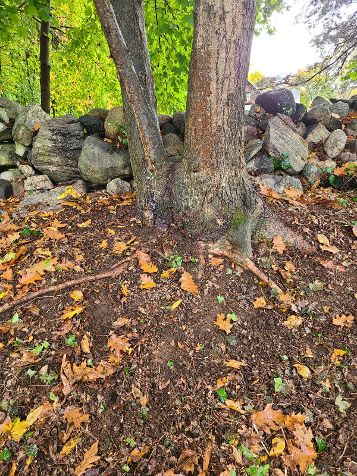
Ivy should be cleared 4 feet in all directions from tree. 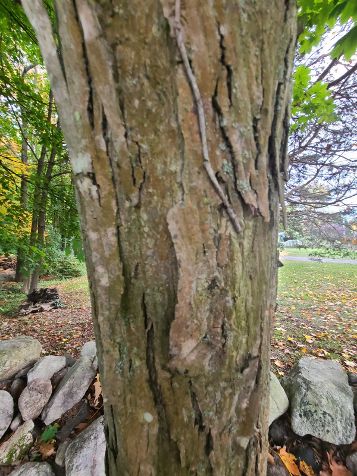
English Ivy stem is still attched to the Shagbark Hickory
Let the English Ivy die back before gently removing it. If you decide to pull off the leaves and stems right away, use care. Pulling ivy can damage the bark of trees and allow bacteria to enter the already weakened tree.
Disposing of English Ivy
Never put English Ivy in compost! Even in a hot compost pile, the plant seeds will survive well enough to be spread to your gardens with the finished compost. Read how to compost here.
You can pile it up and let it rot, preferably on top of rock so it can’t root. If it dries out, you can burn it. We added some to our DIY fire pit, but it made for a very smoky fire.
Or you can bag it up and send it to landfill.
My preference is to let it rot. It takes longer, but I know it’s not going to survive and invade elsewhere. And I hate adding to the landfill.
Controlling English Ivy
If you want to keep your English Ivy under control but not get rid of it all, here are a few tips.
Periodically, hit the ivy patch with a rake, weedwacker, hedgetrimmer or lawnmower. This will make the plant less healthy and therefore less likely to grow big. You can also mulch heavily around the ivy you want to keep. But you’ll have to monitor the plot for stems getting out of bounds and remove them.

Is English Ivy a pretty pest to you? Feel free to share in the comments below.
